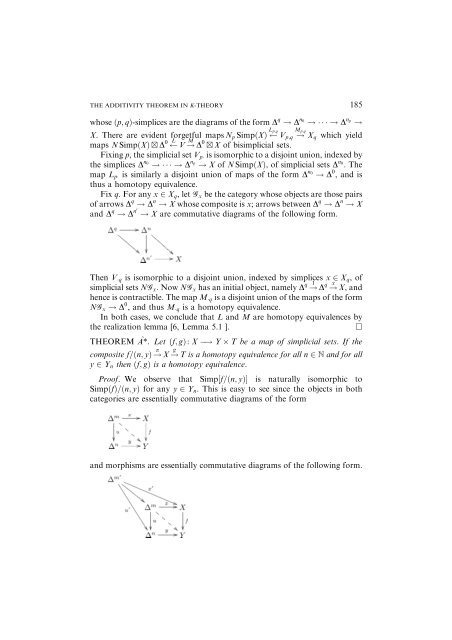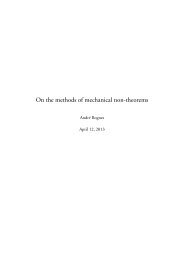The Additivity Theorem in K
The Additivity Theorem in K
The Additivity Theorem in K
Create successful ePaper yourself
Turn your PDF publications into a flip-book with our unique Google optimized e-Paper software.
THE ADDITIVITY THEOREM IN K-THEORY 185<br />
whose ðp; qÞ-simplices are the diagrams of the form D q ! D n0 np ! !D !<br />
X. <strong>The</strong>re are evident forgetful maps Np SimpðXÞ Lp;q<br />
Vp;q ! Mp;q<br />
Xq which yield<br />
maps N SimpðXÞ D 0 L V ! M D 0 X of bisimplicial sets.<br />
Fix<strong>in</strong>g p, the simplicial set Vp is isomorphic to a disjo<strong>in</strong>t union, <strong>in</strong>dexed by<br />
the simplices D n0 np n0 ! !D ! X of N SimpðXÞ, of simplicial sets D . <strong>The</strong><br />
map Lp is similarly a disjo<strong>in</strong>t union of maps of the form D n0 0<br />
! D , and is<br />
thus a homotopy equivalence.<br />
Fix q. For any x 2 Xq, let Gx be the category whose objects are those pairs<br />
of arrows D q ! D n ! X whose composite is x; arrows between D q ! D n ! X<br />
and D q ! D n0<br />
! X are commutative diagrams of the follow<strong>in</strong>g form.<br />
<strong>The</strong>n V q is isomorphic to a disjo<strong>in</strong>t union, <strong>in</strong>dexed by simplices x 2 Xq, of<br />
simplicial sets NGx. Now NGx has an <strong>in</strong>itial object, namely D q ! 1 D q ! x X, and<br />
hence is contractible. <strong>The</strong> map M q is a disjo<strong>in</strong>t union of the maps of the form<br />
NGx ! D 0 , and thus M q is a homotopy equivalence.<br />
In both cases, we conclude that L and M are homotopy equivalences by<br />
the realization lemma [6, Lemma 5.1 ]. h<br />
THEOREM A*. ^ Let ðf; gÞ: X ! Y T be a map of simplicial sets. If the<br />
composite f=ðn; yÞ! p X ! g T is a homotopy equivalence for all n 2 N and for all<br />
y 2 Yn then ðf; gÞ is a homotopy equivalence.<br />
Proof. We observe that Simp½f=ðn; yÞŠ is naturally isomorphic to<br />
SimpðfÞ=ðn; yÞ for any y 2 Yn. This is easy to see s<strong>in</strong>ce the objects <strong>in</strong> both<br />
categories are essentially commutative diagrams of the form<br />
and morphisms are essentially commutative diagrams of the follow<strong>in</strong>g form.

















